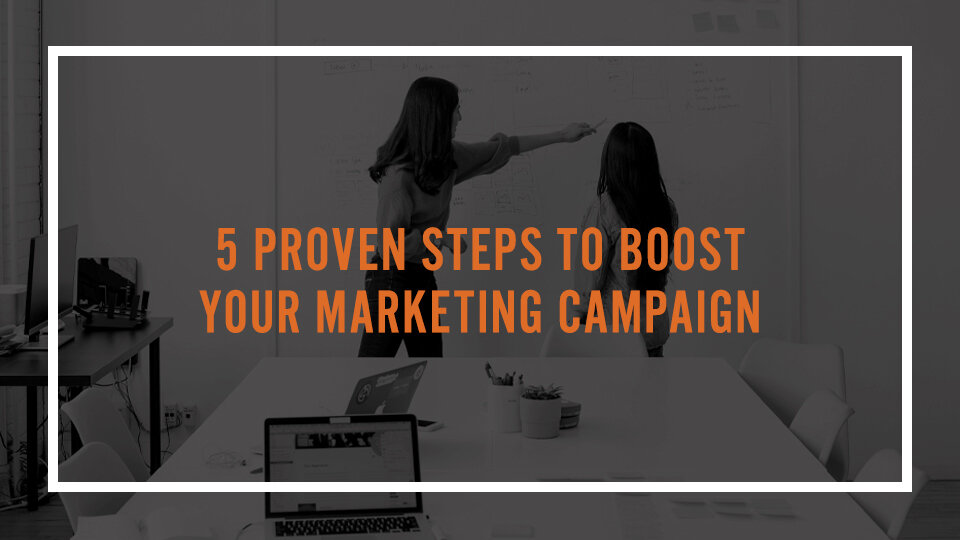5 Proven Steps to Boost Your Marketing Campaign
By Maurilio Amorim
You may have a great idea for a marketing campaign, but without a well thought out strategy, your campaign will likely struggle. After 20 years of comparing successful marketing campaigns with poor-performing ones, our team at The A Group has developed a list of best practices for a successful marketing campaign.
You can learn from your mistakes but the best learning is where you learn from other’s mistakes! We have done the hard work of figuring the top mistakes people make when trying to market services, a product, an event, or anything really. Here’s what we found most organizations were getting wrong and how you can get it right every time:
Don’t start with tactics. They are not strategies.
Failed marketing campaigns start with tactics rather than strategy. Most people confuse tactics such as social media, a website, or an app, for a strategy.
These are marketing tools and they can only do their job if they are in the right place at the right time and targeting the right audience. Starting with a tactic to solve a problem is never a good idea. It’s like setting out on a road trip without a map (old school!) or nav app.
Your social media ads may look good and you may be spending hundreds of dollars a month or even a day on your ad budget but have the ads fall flat and not reach the right people or engage them to attend your event, church, donate to your cause or fill out your contact form.
Define your short- term and long-term goals.
Short-term and long-term goals are essential elements to any marketing campaign. While that might seem obvious to most, it is not widely accomplished.
People often either don’t have a clear win defined for the organization or they simply have an unrealistic one. You must understand what the win is, in a way that is measurable.
For example, you might determine that you want a certain number of prospective member names you want to acquire in a campaign? Or, how many new attenders do we want to attend holiday worship services at our church? Or how many new donors do you wish to attract? These goals help inform campaign efforts.
Understand what your audience(s) want from you.
First of all, you need to understand your audience. Really understand them. What makes them stay awake at night? What are their aspirations? What type of life do they have?
Creating an audience avatar that’s well researched and developed makes all the difference in everything you do in your outreach.
Understanding what your audience wants from you is critical. Most organizations focus on what they want from their audiences: donations, purchases, email addresses, volunteer hours.
But they seldom ask the most important question, “What does my audience want from me?”
Once you understand what your audience wants and needs, you can create marketing personas or avatars so that you can tailor ad copy and creative that speaks directly to what inspires them.
When you write for everyone, you reach no one.
Create compelling strategies based on your audience.
Strategy is a roadmap to lead your audience to a destination.
For example, we want to cultivate people who are interested in serving in our community. So, a strategy would possibly be to create a “Find your place in your community” quiz that walks people through a series of questions and at the end gives them different opportunities to serve at local nonprofits.
You would drive traffic through tactics such as a Google search campaign as well as a social media ad campaign targeted to people in your area who match the volunteer avatar you created during your audience profile.
Again, we started with a wide funnel and continue to refine it.
Most marketing or donor acquisition plans have more than one strategy because organizations often have more than one audience profile. Some people still prefer to donate through an offline paper check.
It’s also just smarter to implement multi-channel strategy. According to The State of Multi-Channel Donor Communications Study, connecting with your audience through multiple channels can provide your nonprofit with three times the value of online-only or offline-only donors.
Develop and deploy tactics.
Tactics work when they are created and deployed as part of a well thought out strategy to reach an audience with a specific goal.
Let’s take the example above. The strategy to reach volunteers in a city might be the creation of a quiz that helps people identify volunteer opportunities in their city.
Tactics would include an SEO optimization of the quiz page so people can easily find it on a Google search, Google ads, Facebook and Instagram ads, an influencer sponsored post, and any other tactic that you would deploy in the places your audience congregates or consumes.
If you know who they are, the language that they respond to, the message that resonates with them and where to find them, then you’ll have a much greater chance to get volunteers to connect with different non-profits in your area.
This framework is solid. It works every time.
The challenge is that the tools and tactics are moving targets. SEO, Facebook and Instagram ad capabilities change constantly and unless you understand the nuances of what goes into managing them, you can waste time and money.
In the past few years I have been teaching people like you to use our marketing and growth framework called GAST we use with all our agency clients.
If you would like to learn how to create a growth plan using the GAST framework. Sign Up Here We’ll let you know the details of our next training.














